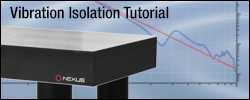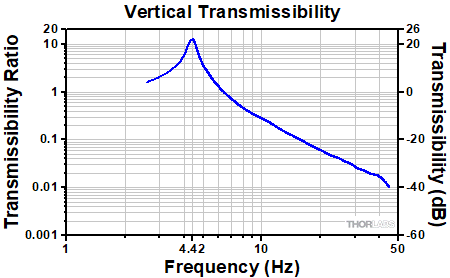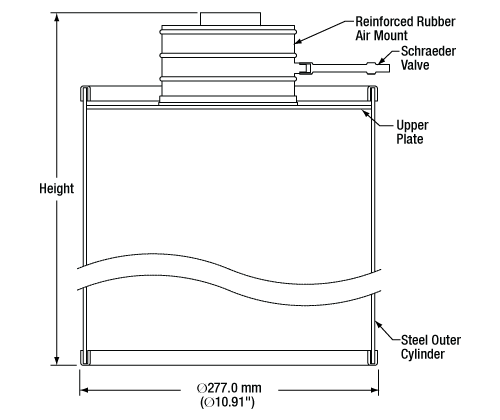Passive Isolation Optical Table Supports

- 600 mm or 700 mm Tall
- Closed Pneumatic Isolation System
- Standard and Heavy Duty Models
- Inflate Using a Simple Foot Pump
PTP702
600 mm Tall,
Standard
PTH703
700 mm Tall,
Heavy Duty
Left: Close-Up of Our Standard Passive Isolators
Right: Close-Up of Our Heavy-Duty (High-Load) Passive Isolators

Please Wait
Features
- Passive Vertical Vibration-Isolating Supports with Oil-Free Design
- High Load Capacity with Excellent Stability
- Standard: 275 - 1100 kg (600 - 2425 lbs)
- Heavy Duty: 550 - 2400 kg (1200 - 5280 lbs)
- Compatible with All of Thorlabs' Nexus® Optical Tables
- Closed Pneumatic Isolation System Isolates Frequencies in the Critical 10 - 50 Hz Range
- Maintain 910 mm (35.8") Optical Table Working Height
- 600 mm (23.6") Legs for 310 mm (12.2") Thick Optical Tables
- 700 mm (27.6") Legs for 210 mm (8.3") Thick Optical Tables
- Sold in Sets of Four
Thorlabs' passive vibration isolation optical table supports can be used with all of our optical tables, and are ideal for general imaging and micropositioning-based experiments. They have a closed pneumatic isolation system that effectively isolates the optical table from floor vibrations throughout the 10 to 50 Hz frequency range. Most sources of vibrations in a lab are within this frequency range, thus these supports are suitable for use in many labs (see the Vibrations tab of the Optical Tables Tutorial).
These isolators provide simple and effective passive vibration isolation with excellent stability. The closed pneumatic isolation system can be inflated with any air pump that has a Schraeder valve. These isolators do not require a constant source of compressed air to maintain isolation. If the pneumatic isolation system is depressurized, the optical table will remain securely supported on and slightly isolated by the reinforced rubber air mount of the optical table supports. Alternatively, if the air chamber is overinflated, vertical stops will prevent the optical table from rising above the maximum designed range. If the table is at either end of the range of motion, the optical table supports will no longer isolate the optical table from floor vibrations. More information about the function and construction of the optical table supports can be found under the Design tab on this page or in the Isolation Systems tab of the Optical Tables Tutorial.
Two versions of each passive isolator are offered: standard, with a load range of 275 - 1100 kg (600 - 2425 lbs) per set of four, and heavy duty, with a load range of 550 - 2400 kg (1200 - 5280 lbs) per set of four. These load capacities are designed to support Thorlabs' complete range of optical tables, which can weigh from 261.6 to 1232.9 kg (484.66 to 2861.60 lbs). Full installation instructions are included; see the manual for details. For higher loads, longer tables, or custom-designed joined systems, more than four isolators may be needed. Please contact Tech Support to discuss your specific requirements.
Tabletop Height
To complement our optical table thicknesses of 210 mm (8.3") and 310 mm (12.2"), our optical table supports are available with heights of either 700 mm (27.6") or 600 mm (23.6") to produce a working height of 910 mm (35.8"). To achieve this working height consistently and to ensure the table is level, please follow the installation instructions in the manual so that the legs are neither overinflated nor underinflated. The manual can be accessed by clicking the red docs icon (![]() ) next to the Item # below. These table supports are also compatible with our 460 mm thick optical tables, but the total height will not be equal to 910 mm (35.8").
) next to the Item # below. These table supports are also compatible with our 460 mm thick optical tables, but the total height will not be equal to 910 mm (35.8").
Specifications
| Item # | PTP702 | PTP703 | PTH702 | PTH703 |
|---|---|---|---|---|
| Isolator Type | Standard Passive Vibration Isolators |
Heavy Duty (High Load) Passive Vibration Isolators |
||
| Vertical Resonant Frequency | 4.42 Hza | 4.42 Hza | ||
| Vertical Transmissibility at Resonance | 22 dBa | 22 dBa | ||
| Vertical Transmissibility at 10 Hz | -11.5 dB (74%)a | -11.5 dB (74%)a | ||
| Load Capacity (Set of Four) |
275 - 1100 kg (600 - 2425 lbs) |
550 - 2400 kg (1200 - 5280 lbs) |
||
| Height | 600 mm (23.6") | 700 mm (27.6") | 600 mm (23.6") | 700 mm (27.6") |
| Air Pressure (Recommended) | 65 to 75 psi (448 to 517 kPa) | 65 to 75 psi (448 to 517 kPa) | ||
| Air Pressure (Maximum) | 80 psi (550 kPa) | 80 psi (550 kPa) | ||
Transmissibility
An optical table system is subjected to continuous vibrational impulses from the laboratory floor. These vibrations may be caused by large machinery within the building or even by wind or traffic-excited building resonances (swaying). Transmissibility is a measure of the isolator's efficiency at damping out these vibrations and is defined as the ratio of the amplitude of the transmitted vibration to that of the forcing vibration.
Other common ways to represent this ratio are:
Percent of isolation = (1 - transmissibility ratio) x 100 or
Isolation in dB = 20 x log(transmissibility ratio)
At resonance, the system amplifies the input vibration so that the transmissibility ratio is greater than one. The transmissibility ratio is dependent on several factors; for instance the ratio will be dependent on the load placed on the isolators. Remember that the isolators only damp vibrations transmitted through the legs of the frame from the floor; air handling systems are often a significant source of vibration that is transmitted to the work surface through the air. As a result, in applications particularly sensitive to vibrations a comprehensive evaluation of the environment is recommended before choosing a vibration isolation platform. For more information on this topic please see our Vibration Isolation Tutorial.
Common Vibration Sources
| Types | Frequency (Hz) | Amplitude (inches) |
|---|---|---|
| Air Compressors | 4 – 20 | 10-2 |
| Handling Equipment | 5 – 40 | 10-3 |
| Pumps | 5 – 25 | 10-3 |
| Building Services | 7 – 40 | 10-4 |
| Foot Traffic | 0.5 – 6 | 10-5 |
| Elevators | Up to 40 | 10-3 to 10-5 |
| Building Motion | 46/Height in meters | 10-1 |
| Building Pressure Waves | 1 – 5 | 10-5 |
| Railroad* | 5 - 20 | +/-0.15g |
| Highway Traffic* | 5 - 100 | +/-0.001g |
*Amplitude is reported in dB using the acceleration due to gravity as the reference acceleration.
| Feature | Design |
|---|---|
| Vibration Isolation | Damped Pneumatic Spring: Damping of vibrations is achieved by the use of a reinforced rubber air chamber. The air chamber is connected by tubing to a Schraeder valve so that once the air chamber is inflated, the source of compressed air or the pump used to pressurize the chamber can be removed. The table is supported by the air pressure in the chamber, which can be adjusted to compensate for a change in the load placed on the optical table. The volume and stiffness of the reinforced rubber air chamber has been optimized to minimize the resonant frequency of the optical table supports while maximizing the damping performance for our complete range of tabletops. |
| Stable Support | Large-Diameter Cylindrical Design: The large-diameter, free-standing optical table supports provide excellent stability and safety. |
| Height | Cylindrical Steel Supports: To complement our optical table thicknesses of 210 mm (8.3") and 310 mm (12.2"), our optical table supports are available with heights of either 700 mm (27.6") or 600 mm (23.6") to produce a working height of 910 mm (35.8"). |
When passive vibration isolation optical table supports are used in a lab where the load placed on the optical table is frequently changing, it is sometimes advantageous to use a pressure regulator in conjunction with a constant source of compressed air. This allows the user to quickly level the optical table by adjusting the pressure in the air chamber of each optical table support.
| Posted Comments: | |
mitch
(posted 2018-06-07 08:36:37.267) Hi, when I use these will the height of the table change? If I were to pump the isolators to a known pressure then I guess the table will return to the same height? How often will I have to "top up" the air inside? Thanks rmiron
(posted 2018-06-13 11:16:01.0) Response from Radu at Thorlabs: The answer is, most likely, yes. If the isolators are inflated as advised in the manual, the table will be at a height of either 600mm or 700mm. If they are over or under inflated, then the table will be above, respectively below that nominal height. Regarding the frequency of top-ups, we can't offer an exact specification. This frequency will vary from batch to batch and will also depend on the magnitude and distribution of the load. With that being said, I recommend that you check the state of the isolators on a weekly basis. rachid
(posted 2015-11-22 00:56:35.92) I would like to have two small optical tables with the following size:
1. 800 mm x 800 mm and
2. 800 mm x 600 mm
both tables with 21 mm.
In addition I would like to have two set of PTP603
(700 mm Tall)for the two tables.
We hope to get a good price as my budget is very limited.
Last years we bought several items from your company and I hope to get special price.
Thank you,
Rachid Sbiaa
rachid@squ.edu.om besembeson
(posted 2015-11-25 11:34:29.0) Response from Bweh at Thorlabs USA: I will followup with you on the special table quotations and we will apply any discounts that you qualify for according to our discount policy here: http://www.thorlabs.us/discountPolicy.cfm rachid
(posted 2015-11-22 00:56:24.347) I would like to have two small optical tables with the following size:
1. 800 mm x 800 mm and
2. 800 mm x 600 mmm
both tables with 21 mm.
In addition I would like to have two set of PTP603
(700 mm Tall)for the two tables.
We hope to get a good price as my budget is very limited.
Last years we bought several items from your company and I hope to get special price.
Thank you,
Rachid Sbiaa
rachid@squ.edu.om lsandstrom
(posted 2009-10-09 08:00:02.0) Why does all the comments disappear if you hit the submit feedback button if you by accident used an invalid e-mail adress. The back function did not work thus I had to retype all comments again. |
Optical Table Supports Comparison Table
| Active Vibration Isolation Supports |
Standard Passive Vibration Isolation Supports |
Heavy Duty Passive Vibration Isolation Supports |
Rigid, Non-Isolating Supports | |
|---|---|---|---|---|
| Vertical Resonant Frequencya | 1.35 Hz | 4.42 Hz | 4.42 Hz | N/A |
| Vertical Transmissibility at Resonancea | 10 dB | 22 dB | 22 dB | N/A |
| Vertical Transmissibility at 10 Hza | 97.5% | 74% | 74% | N/A |
| Isolation Type | Active | Passive | Passive | Noneb |
| Load Capacity (Set of Four) | 2500 kg (5500 lbs) | 275 - 1100 kg (600 - 2425 lbs) | 550 - 2400 kg (1200 - 5280 lbs) | 2500 kg (5500 lbs) |
 Products Home
Products Home










 Click to Enlarge
Click to Enlarge

 Supports with Passive Isolators
Supports with Passive Isolators